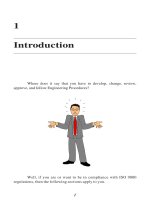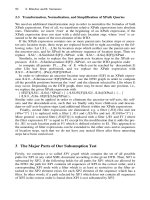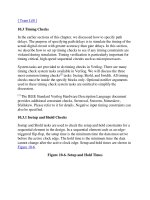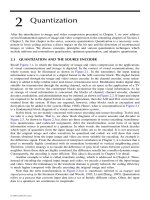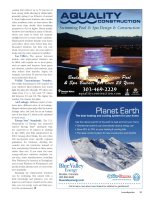Tài liệu Anomalies and Curiosities of Medicine, by George M. Gould and Walter Lytle Pyle doc
Bạn đang xem bản rút gọn của tài liệu. Xem và tải ngay bản đầy đủ của tài liệu tại đây (5.68 MB, 3,621 trang )
The Project Gutenberg EBook of Anomalies
and Curiosities of Medicine, by
George M. Gould and Walter Lytle Pyle
This eBook is for the use of anyone
anywhere at no cost and with
almost no restrictions whatsoever. You
may copy it, give it away or
re-use it under the terms of the Project
Gutenberg License included
with this eBook or online at
www.gutenberg.net
Title: Anomalies and Curiosities of
Medicine
Author: George M. Gould
Walter Lytle Pyle
Posting Date: August 3, 2008 [EBook
#747]
Release Date: December, 1996
Language: English
*** START OF THIS PROJECT GUTENBERG
EBOOK ANOMALIES, CURIOSITIES OF MEDICINE
***
Produced by Charles Keller. HTML version
by Al Haines.
ANOMALIES and
CURIOSITIES of
MEDICINE
Being an encyclopedic collection of rare
and extraordinary cases, and of the most
striking instances of abnormality in all
branches of medicine and surgery, derived
from an exhaustive research of medical
literature from its origin to the present day,
abstracted, classified, annotated, and
indexed.
by
GEORGE M.
GOULD, A.M., M.D.
and
WALTER L. PYLE,
A.M., M.D.
PREFATORY AND
INTRODUCTORY.
Since the time when man's mind first
busied itself with subjects beyond his
own self-preservation and the
satisfaction of his bodily appetites, the
anomalous and curious have been of
exceptional and persistent fascination to
him; and especially is this true of the
construction and functions of the human
body. Possibly, indeed, it was the
anomalous that was largely instrumental
in arousing in the savage the attention,
thought, and investigation that were
finally to develop into the body of
organized truth which we now call
Science. As by the aid of collected
experience and careful inference we to-
day endeavor to pass our vision into the
dim twilight whence has emerged our
civilization, we find abundant hint and
even evidence of this truth. To the
highest type of philosophic minds it is
the usual and the ordinary that demand
investigation and explanation. But even
to such, no less than to the most naive-
minded, the strange and exceptional is of
absorbing interest, and it is often through
the extraordinary that the philosopher
gets the most searching glimpses into the
heart of the mystery of the ordinary.
Truly it has been said, facts are stranger
than fiction. In monstrosities and
dermoid cysts, for example, we seem to
catch forbidden sight of the secret work-
room of Nature, and drag out into the
light the evidences of her clumsiness,
and proofs of her lapses of skill,—
evidences and proofs, moreover, that tell
us much of the methods and means used
by the vital artisan of Life,—the loom,
and even the silent weaver at work upon
the mysterious garment of corporeality.
"La premiere chose qui s'offre a l'
Homme quand il se regarde, c'est son
corps," says Pascal, and looking at the
matter more closely we find that it was
the strange and mysterious things of his
body that occupied man's earliest as
well as much of his later attention. In the
beginning, the organs and functions of
generation, the mysteries of sex, not the
routine of digestion or of locomotion,
stimulated his curiosity, and in them he
recognized, as it were, an unseen hand
reaching down into the world of matter
and the workings of bodily organization,
and reining them to impersonal service
and far-off ends. All ethnologists and
students of primitive religion well know
the role that has been played in primitive
society by the genetic instincts. Among
the older naturalists, such as Pliny and
Aristotle, and even in the older
historians, whose scope included natural
as well as civil and political history, the
atypic and bizarre, and especially the
aberrations of form or function of the
generative organs, caught the eye most
quickly. Judging from the records of
early writers, when Medicine began to
struggle toward self-consciousness, it
was again the same order of facts that
was singled out by the attention. The
very names applied by the early
anatomists to many structures so widely
separated from the organs of generation
as were those of the brain, give
testimony of the state of mind that led to
and dominated the practice of dissection.
In the literature of the past centuries the
predominance of the interest in the
curious is exemplified in the almost
ludicrously monotonous iteration of
titles, in which the conspicuous words
are curiosa, rara, monstruosa,
memorabilia, prodigiosa, selecta,
exotica, miraculi, lusibus naturae,
occultis naturae, etc., etc. Even when
medical science became more strict, it
was largely the curious and rare that
were thought worthy of chronicling, and
not the establishment or illustration of
the common, or of general principles.
With all his sovereign sound sense,
Ambrose Pare has loaded his book with
references to impossibly strange, and
even mythologic cases.
In our day the taste seems to be
insatiable, and hardly any medical
journal is without its rare or "unique"
case, or one noteworthy chiefly by
reason of its anomalous features. A
curious case is invariably reported, and
the insertion of such a report is generally
productive of correspondence and
discussion with the object of finding a
parallel for it.
In view of all this it seems itself a
curious fact that there has never been any
systematic gathering of medical
curiosities. It would have been most
natural that numerous encyclopedias
should spring into existence in response
to such a persistently dominant interest.
The forelying volume appears to be the
first thorough attempt to classify and
epitomize the literature of this nature. It
has been our purpose to briefly
summarize and to arrange in order the
records of the most curious, bizarre, and
abnormal cases that are found in medical
literature of all ages and all languages—
a thaumatographia medica. It will be
readily seen that such a collection must
have a function far beyond the
satisfaction of mere curiosity, even if
that be stigmatized with the word "idle."
If, as we believe, reference may here be
found to all such cases in the literature
of Medicine (including Anatomy,
Physiology, Surgery, Obstetrics, etc.) as
show the most extreme and exceptional
departures from the ordinary, it follows
that the future clinician and investigator
must have use for a handbook that
decides whether his own strange case
has already been paralleled or excelled.
He will thus be aided in determining the
truth of his statements and the accuracy
of his diagnoses. Moreover, to know
extremes gives directly some knowledge
of means, and by implication and
inference it frequently does more.
Remarkable injuries illustrate to what
extent tissues and organs may be
damaged without resultant death, and
thus the surgeon is encouraged to
proceed to his operation with greater
confidence and more definite knowledge
as to the issue. If a mad cow may blindly
play the part of a successful obstetrician
with her horns, certainly a skilled
surgeon may hazard entering the womb
with his knife. If large portions of an
organ,—the lung, a kidney, parts of the
liver, or the brain itself,—may be lost by
accident, and the patient still live, the
physician is taught the lesson of nil
desperandum, and that if possible to
arrest disease of these organs before
their total destruction, the prognosis and
treatment thereby acquire new and more
hopeful phases.
Directly or indirectly many similar
examples have also clear medicolegal
bearings or suggestions; in fact, it must
be acknowledged that much of the
importance of medical jurisprudence
lies in a thorough comprehension of the
anomalous and rare cases in Medicine.
Expert medical testimony has its chief
value in showing the possibilities of the
occurrence of alleged extreme cases,
and extraordinary deviations from the
natural. Every expert witness should be
able to maintain his argument by a full
citation of parallels to any remarkable
theory or hypothesis advanced by his
clients; and it is only by an exhaustive
knowledge of extremes and anomalies
that an authority on medical
jurisprudence can hope to substantiate
his testimony beyond question. In every
poisoning case he is closely questioned
as to the largest dose of the drug in
question that has been taken with
impunity, and the smallest dose that has
killed, and he is expected to have the
cases of reported idiosyncrasies and
tolerance at his immediate command. A
widow with a child of ten months'
gestation may be saved the loss of
reputation by mention of the authentic
cases in which pregnancy has exceeded
nine months' duration; the proof of the
viability of a seven months' child may
alter the disposition of an estate; the
proof of death by a blow on the
epigastrium without external marks of
violence may convict a murderer; and so
it is with many other cases of a
medicolegal nature.
It is noteworthy that in old-time
medical literature—sadly and unjustly
neglected in our rage for the new—
should so often be found parallels of our
most wonderful and peculiar modern
cases. We wish, also, to enter a mild
protest against the modern egotism that
would set aside with a sneer as myth and
fancy the testimonies and reports of
philosophers and physicians, only
because they lived hundreds of years
ago. We are keenly appreciative of the
power exercised by the myth-making
faculty in the past, but as applied to
early physicians, we suggest that the
suspicion may easily be too active.
When Pare, for example, pictures a
monster, we may distrust his art, his
artist, or his engraver, and make all due
allowance for his primitive knowledge
of teratology, coupled with the
exaggerations and inventions of the
wonder-lover; but when he describes in
his own writing what he or his confreres
have seen on the battle-field or in the
dissecting room, we think, within
moderate limits, we owe him credence.
For the rest, we doubt not that the
modern reporter is, to be mild, quite as
much of a myth-maker as his elder
brother, especially if we find modern
instances that are essentially like the
older cases reported in reputable
journals or books, and by men
presumably honest. In our collection we
have endeavored, so far as possible, to
cite similar cases from the older and
from the more recent literature.
This connection suggests the question
of credibility in general. It need hardly
be said that the lay-journalist and
newspaper reporter have usually been
ignored by us, simply because
experience and investigation have many
times proved that a scientific fact, by
presentation in most lay-journals,
becomes in some mysterious manner,
ipso facto, a scientific caricature (or
worse!), and if it is so with facts, what
must be the effect upon reports based
upon no fact whatsoever? It is manifestly
impossible for us to guarantee the
credibility of chronicles given. If we
have been reasonably certain of
unreliability, we may not even have
mentioned the marvelous statement.
Obviously, we could do no more with
apparently credible cases, reported by
reputable medical men, than to cite
author and source and leave the matter
there, where our responsibility must end.
But where our proper responsibility
seemed likely never to end was in
carrying out the enormous labor
requisite for a reasonable certainty that
we had omitted no searching that might
lead to undiscovered facts, ancient or
modern. Choice in selection is always,
of course, an affair de gustibus, and
especially when, like the present, there
is considerable embarrassment of riches,
coupled with the purpose of
compressing our results in one handy
volume. In brief, it may be said that
several years of exhaustive research
have been spent by us in the great
medical libraries of the United States
and Europe in collecting the material
herewith presented. If, despite of this,
omissions and errors are to be found, we
shall be grateful to have them pointed
out. It must be remembered that limits of
space have forbidden satisfactory
discussion of the cases, and the prime
object of the whole work has been to
carefully collect and group the
anomalies and curiosities, and allow the
reader to form his own conclusions and
make his own deductions.
As the entire labor in the preparation
of the forelying volume, from the
inception of the idea to the completion of
the index, has been exclusively the
personal work of the authors, it is with
full confidence of the authenticity of the
reports quoted that the material is
presented.
Complete references are given to those
facts that are comparatively unknown or
unique, or that are worthy of particular
interest or further investigation. To
prevent unnecessary loading of the book
with foot-notes, in those instances in
which there are a number of cases of the
same nature, and a description has not
been thought necessary, mere citation
being sufficient, references are but
briefly given or omitted altogether. For
the same reason a bibliographic index
has been added at the end of the text.
This contains the most important sources
of information used, and each journal or
book therein has its own number, which
is used in its stead all through the book
(thus, 476 signifies The Lancet, London;
597, the New York Medical Journal;
etc.). These bibliographic numbers begin
at 100.
Notwithstanding that every effort has
been made to conveniently and
satisfactorily group the thousands of
cases contained in the book (a labor of
no small proportions in itself), a
complete general index is a practical
necessity for the full success of what is
essentially a reference-volume, and
consequently one has been added, in
which may be found not only the subjects
under consideration and numerous cross-
references, but also the names of the
authors of the most important reports. A
table of contents follows this preface.
We assume the responsibility for
innovations in orthography, certain
abbreviations, and the occasional
substitution of figures for large
numerals, fractions, and decimals, made
necessary by limited space, and in some
cases to more lucidly show tables and
statistics. From the variety of the
reports, uniformity of nomenclature and
numeration is almost impossible.
As we contemplate constantly
increasing our data, we shall be glad to
receive information of any unpublished
anomalous or curious cases, either of the
past or in the future.
